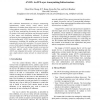Free Online Productivity Tools
i2Speak
i2Symbol
i2OCR
iTex2Img
iWeb2Print
iWeb2Shot
i2Type
iPdf2Split
iPdf2Merge
i2Bopomofo
i2Arabic
i2Style
i2Image
i2PDF
iLatex2Rtf
Sci2ools
DISCEX
2003
IEEE
2003
IEEE
ANON: An IP-Layer Anonymizing Infrastructure
This exhibition demonstrates an IP-layer anonymizing infrastructure, called ANON, which allows server addresses to be hidden from clients and vice versa. In providing address anonymity, ANON uses a network resident set of IP-layer anonymizing forwarders that can forward IP packets with nested encryption and decryption applied to their source and destination addresses. To prevent adversaries from compromising the anonymity by learning the forwarding path, ANON incorporates a suite of countermeasures, including link padding and non-malleable, semantically secure link encryption. To prevent denial of service (DoS) attacks through the anonymizing infrastructure itself, ANON uses rate limiting. Finally, to increase the resilience against attacks and infrastructure failures, ANON uses redundant forwarders with anycast addresses and a fault-tolerant overlay network to connect forwarders.
ANON | DISCEX 2003 | Information Management | IP-layer Anonymizing Forwarders | IP-layer Anonymizing Infrastructure |
| Added | 04 Jul 2010 |
| Updated | 04 Jul 2010 |
| Type | Conference |
| Year | 2003 |
| Where | DISCEX |
| Authors | Chen-Mou Cheng, H. T. Kung, Koan-Sin Tan, Scott Bradner |
Comments (0)

